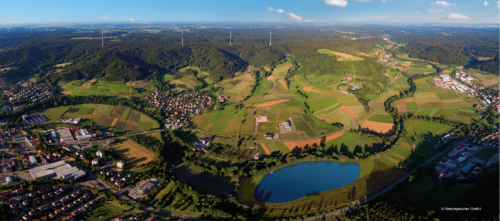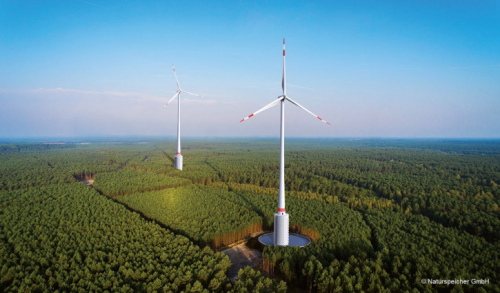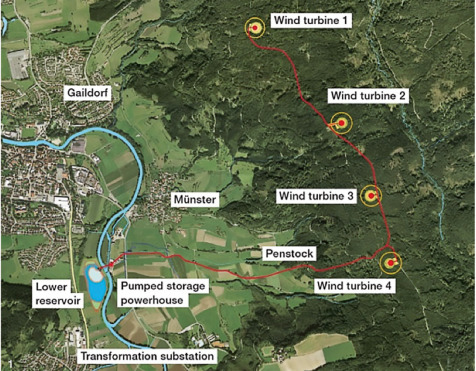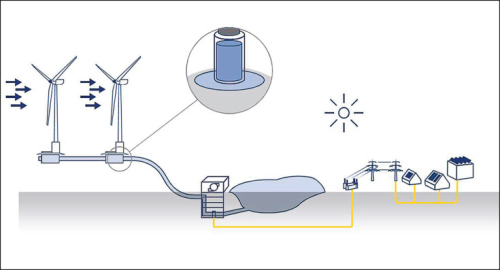



The project is being funded with a €7.15 million grant from the Environmental Innovation Programme by the German Federal Ministry for the Environment, Nature Conservation, Building and Nuclear Safety. It makes use of the towers and bases of wind turbines with a total capacity of 160,000 m3 as water reservoirs which makes it possible to increase hub heights by an additional 40 m. As a result, it's possible to increase power generation from wind energy by up to 25%. In terms of building construction and machinery, the Naturstromspeicher uses standardised technology throughout, which means competitive costs and ensuring long-term operation of the installations.
How it works
Headquartered in Germany, international technology group, Voith, will provide the pump turbines for this special project. The three reversible Francis machines with a total output of 16 MW will be a core element in the plant. The principle behind the operation is both simple and ingenious. If there is a surplus of power, the pumped storage power station switches to pumping mode, moving water from a lower reservoir to the higher storage basin in the wind towers. If the demand for electricity in the grid rises, water is released from the upper basin to the bottom via a penstock and causes the pump turbines to move. Within seconds, electricity is generated and fed back into the electricity grid.
A pilot project is now under construction near the small town of Gaildorf, which has a population of 12,000 residents and is located in the northeast of the German federal state of Baden-Württemberg. Future PSPs will be available in three standardized output classes, i.e. 16MW, 24MW or 32 MW. They will have certified approval, and are designed for a gross head range from 150 m to 350 m between the lower and upper reservoir. In order to minimize the environmental impact, the upper reservoir of the pumped storage plant (PSP) has been integrated into the bottom part of each wind tower (active reservoir), as well as the surrounding area of all four wind towers (passive reservoir). The flat passive reservoir is decoupled by a shut-off valve from the active reservoir whenever the maximum pool level is reached. The material that is excavated during the construction of the wind tower foundation will be re-used to backfill behind the concrete pool wall, in order to provide support and a smooth transition to the natural surface. The red line in the aerial view below shows the routing of the underground penstock, which first connects the four individual upper reservoirs. The total upper reservoir volume is 160,000 m3, and can provide four hours of full load operation in turbine mode. Typically, a penstock routing does not have as many bends, but in this case the penstock routing follows the existing forest service roads in order to prevent deforestation. The fourth active reservoir also acts as a surge tank, allowing for fast load gradients during operation of the PSP.An adjacent area of the Kocher River (lower reservoir) has a dual use.
During normal flow conditions of the river, the lower basin will accommodate 160,000 m3 of water if the upper reservoirs are emptied, plus an additional 10,000 m3 of evaporation reserves and 10,000 m3 for minimum water storage, which is necessary for ecological reasons (e.g. fish population). The lower reservoir can also accommodate an additional 30,000 m3 during a 10-year flood condition, i.e. the lower reservoir can be used as a retention pond in emergency cases. For these reasons, the total storage capacity of the lower reservoir is 210,000 m3. This slightly oversized lower reservoir was welcomed by the city authorities of Gaildorf, because they had to cope with new flood control requirements, i.e. obligations to invest in flood control to accommodate the 30,000 m3 (10-year flood event).
Benefits of a hybrid plant
Important aspects of the hybrid plant are the synergies between technologies. The planning costs for the combined plant are significantly lower than they would be for the construction of separate sites. The infrastructure of the service road is a one-time build. The PSP and wind turbines use the same grid connection. When possible, the wind turbine cables share a trench with the penstock. The four wind generators and the three motor-generators of the PSP are connected to the same substation via 20 kV buried cables. The technical and ecological benefits of this solution were communicated yo local residents and authorities at an early stage by a team of experts. This team included engineers, geologists, biologists, geo-ecologists, noise abatement and community relationship experts. The power house is of a deep excavated type, comprising the three identical reversible and variable-speed pump-turbines, and three squirrel cage type induction Motor-Generators (asynchronous MG). The total active power for the Gaildorf PSP will be approximately 16 MW. The stator terminals of each MG are connected to a four quadrant 3-level Voltage Source Inverter (VSI) using IGCT technology for the power semiconductors. The envisaged VSIs are able to directly control the mechanical shaft torque (DTC technology). This solution allows a very high operational flexibility in the competitive German market environment.
The advantages of the variable-speed solution allow for fast load control in both pump and turbine mode, which is important to integrate volatile renewables within the grid network. Other advantages are that such units can be operated with higher water head variations, and the part load limits in turbine mode may drop to lower values. Another focus was to improve the dynamic responses of the pumped storage when supplying ancillary services. For example, all three vertical power units have the ability to supply positive primary frequency control, i.e. the start-up time in turbine mode from stand still to full load should be 30 seconds.



